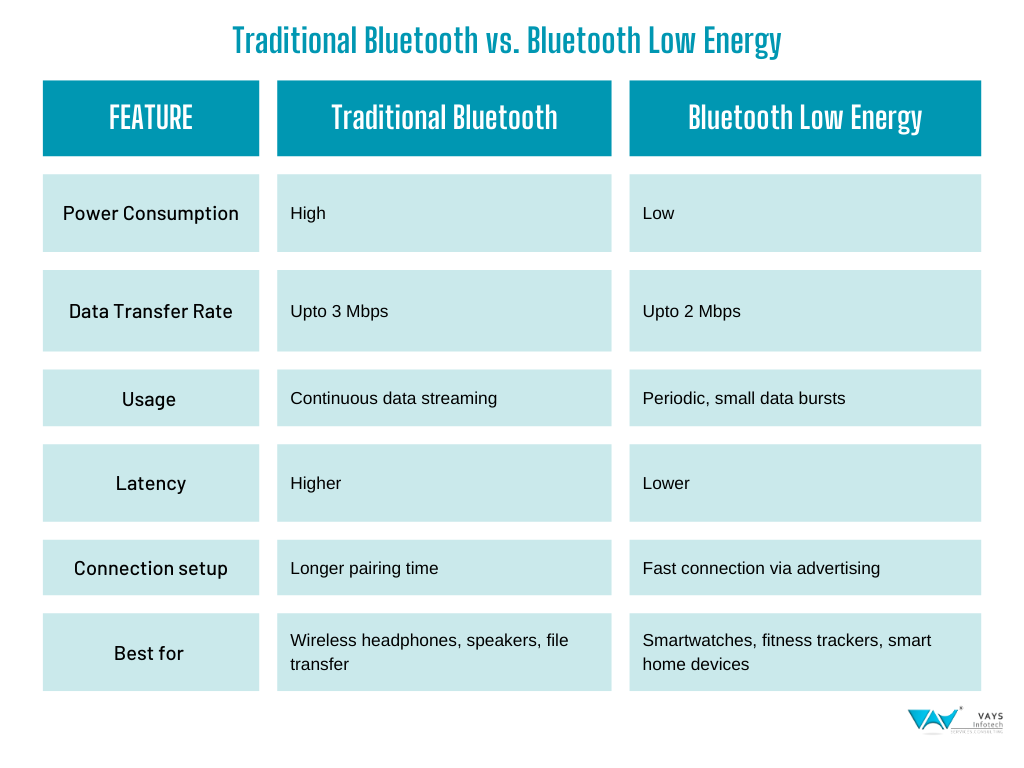Bluetooth Low Energy (BLE) is a wireless communication technology for low-power devices in short range. It is widely used in smart devices, to enhance connectivity and energy efficiency.
How does BLE work?
BLE (Bluetooth Low Energy) operates in the 2.4 GHz ISM band. But, it uses a different modulation and frequency hopping mechanism to minimize interference. It also optimises power consumption.
BLE devices can operate in different roles:
- Peripheral: A low-power device that transmits data (e.g., a heart rate monitor, smart sensor).
- Central: A more powerful device that scans and connects with peripherals (e.g., a smartphone or laptop).
BLE communication occurs through advertising and connection modes. In advertising mode, the peripheral device broadcasts signals that nearby central devices can detect. Once connected, data is exchanged efficiently while maintaining low power usage.

Function of BLE in Wi-Fi Devices
Wi-Fi and BLE serve different purposes but often work together in modern devices. Here are some key functions of BLE in Wi-Fi-enabled devices:
Seamless Device Pairing
Many Wi-Fi devices use BLE for quick and easy pairing. For example, smart home devices like security cameras and smart bulbs use BLE during the initial setup process. Users connect to the device using BLE, configure Wi-Fi settings and then switch to Wi-Fi for normal operation.
Energy-Efficient Connectivity
Wi-Fi consumes more power compared to BLE. Devices such as smart speakers or thermostats use BLE to maintain low-power connectivity when Wi-Fi is not needed. This extends battery life and improves device efficiency.
IoT and Smart Home Integration
BLE is crucial for IoT ecosystems. Many Wi-Fi-enabled smart home devices use BLE to communicate with each other or with a central hub (such as a smart speaker or smartphone), ensuring a seamless user experience.
Location and Proximity Detection
BLE is widely used for indoor positioning and proximity-based services. Wi-Fi routers with BLE capabilities can detect nearby BLE-enabled devices, offering features like smart unlocking, automated settings adjustments and enhanced security measures.
Firmware Updates and Diagnostics
Some Wi-Fi devices use BLE to facilitate firmware updates, diagnostics and troubleshooting when a Wi-Fi connection is unstable or unavailable. This ensures uninterrupted updates and maintenance.
Detailed Working of BLE in Wi-Fi Devices
BLE enhances Wi-Fi devices through a seamless integration process. Here’s how it works:
- Device Discovery: BLE-enabled Wi-Fi devices start by broadcasting advertising packets containing their identity and available services.
- Pairing and Authentication: The user connects to the device using a mobile app or another BLE-supported device to configure settings and authentication.
- Wi-Fi Setup: Once paired, the device can share Wi-Fi credentials securely through BLE, ensuring a smooth transition to the Wi-Fi network.
- Operational Mode: After connecting to Wi-Fi, BLE remains available for low-power tasks like status updates, device monitoring and energy-efficient communication when the device is idle.
Bluetooth Low Energy plays a vital role in Wi-Fi-enabled devices by providing efficient pairing, low-power communication and enhanced connectivity features. By integrating BLE, manufacturers can create smart devices that are more user-friendly, energy-efficient and seamlessly connected in the modern digital ecosystem. As IoT and smart home technologies continue to grow, BLE’s significance in Wi-Fi devices will only become more prominent.
To know more about Cisco Meraki WiFi devices, click here on Cisco Meraki
To know more about HPE Aruba Wifi devices, click here on HPE Aruba

